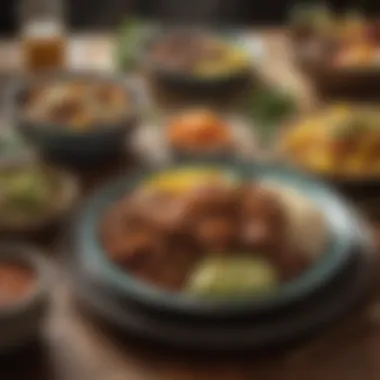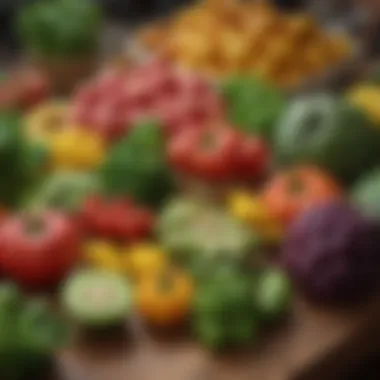Exploring Jamaica's Culinary Heritage: Flavors & Traditions


Intro
Jamaican cuisine is a rich tapestry of flavors, influenced by its history and diverse cultures. From the vibrant spices to the fresh ingredients, the Jamaican kitchen offers a unique culinary experience. This exploration into Jamaican culinary traditions reveals the essential dishes and the stories behind them. Each recipe serves not just as sustenance but also as a link between generations.
Understanding what makes Jamaican cooking distinct is vital for appreciating the culture it comes from. The interplay of Indigenous, African, European, and Asian elements creates a cuisine that is both complex and approachable. Readers will learn about foundational ingredients, traditional cooking methods, and how these have evolved over time.
The objective here is to provide a comprehensive guide for both novices and experienced cooks. The insights shared should inspire culinary exploration and appreciation for Jamaican food.
"Food in Jamaica is not just a meal; it’s a celebration of heritage and culture."
In the following sections, we will delve into specific recipes, explore key ingredients, and discuss cooking techniques that are central to this rich kitchen.
Historical Context of Jamaican Cuisine
Understanding the historical context of Jamaican cuisine gives crucial insight into the rich tapestry of flavors and traditions that define it. The unique identity of Jamaican food arises from a blend of indigenous practices, colonial influences, and the interactions among various cultures that have settled on the island. This section intends to unravel the significance of these elements, examining their impact on the culinary landscape of Jamaica.
Colonial Influences
Colonialism played a substantial role in shaping Jamaican cuisine. The British, Spanish, and Portuguese colonizers introduced numerous ingredients and culinary techniques that integrated with local customs. For example, the British plantation system introduced the use of sugar, which later became a staple in many Jamaican desserts. Similarly, settlers brought livestock such as pigs and cows, which altered the protein sources available to natives.
The impact of these colonial powers was not merely about ingredient introduction; it was also about the adaptation of cooking methods. Stewing, baking, and roasting techniques were assimilated and now form a core part of preparing traditional dishes.
This interaction led to the development of dishes that reflect a confluence of styles. For example,
- Escovitch fish incorporates a British frying technique with local spices and vegetables.
- Jerk chicken exemplifies the fusion of indigenous methods with influences from British seasoning practices.
Thus, colonialism not only influenced Jamaican cuisine by adding to its ingredients but also by enriching its cooking methodologies, creating a complex culinary identity.
Indigenous Ingredients
Prior to the arrival of European settlers, Jamaica was home to the Taíno people. Their use of native ingredients laid the groundwork for a vibrant culinary landscape. Foods like cassava, yam, and callaloo were staple crops that contributed to the island's dietary practices.
Cassava is versatile; it is used to make bammy, a flatbread that accompanies many meals. Yam, often cooked and served with various stews or fried, remains popular in Jamaican households. Callaloo, similar to spinach, is commonly sautéed with onions and peppers and served as a side dish.
These indigenous ingredients played a crucial role in shaping the flavor profile of traditional Jamaican cooking. Knowing these roots aids in appreciating the depth of flavor and variety each dish offers, as they blend seamlessly with the introduced spices and ingredients.
Cultural Fusion
The beauty of Jamaican cuisine lies in its cultural fusion. The island has seen migrations and interactions among various ethnic groups, including Africans, East Indians, and Chinese. Each group brought distinct flavors, cooking methods, and ingredients that have become staples in Jamaican kitchens.
African influences are particularly prominent in Jamaican cooking. The cooking practice of one-pot meals is reminiscent of West African traditions, leading to recipes like rice and peas that incorporate coconut milk and spices to create rich, savory flavors.
East Indian contributions include the use of spices such as curry powder, which has been integrated into popular dishes like curried goat. Similarly, Chinese immigrants influenced the island’s culinary options, introducing dishes like fried rice and chow mein, now adapted into local styles.
This blend of cultures not only enhances the complexity of Jamaican cuisine but also reflects the resilient spirit and creativity of its people.
The culinary journey of Jamaica is an embodiment of its history, translating stories of its people into flavors and traditions that are as rich as its past.
Essential Ingredients of Jamaican Kitchens
Understanding the essential ingredients of Jamaican kitchens is fundamental to appreciating the vibrant tapestry of flavors that characterize this cuisine. Each ingredient, from herbs to spices, plays a pivotal role in creating the distinctive taste profiles synonymous with Jamaican dishes. Moreover, the ingredients reflect the island's culinary heritage and cultural influences, connecting history, tradition, and the everyday kitchen. Exploring these ingredients not only highlights their individual roles but also emphasizes how they work together to form a coherent culinary identity.
Pimento and Allspice
Pimento, also known as allspice, stands out as a critical ingredient in Jamaican cooking. Its unique flavor is a blend of cinnamon, nutmeg, and cloves, making it incredibly versatile. Pimento is often used in marinades for meats, especially in the famous jerk seasoning. This all-purpose spice contributes depth to various dishes, infusing them with warmth and complexity. Additionally, its use in both sweet and savory recipes demonstrates its adaptability and significance in balancing flavors. Pimento has the ability to enhance dishes without overpowering other ingredients, a quality that is paramount in Jamaican cooking.
Scotch Bonnet Peppers
Scotch bonnet peppers are another cornerstone of Jamaican cuisine. They are known for their fiery heat and distinct fruity flavor. These peppers do not just add spice; they bring a level of complexity to dishes that few other ingredients can match. Used in sauces, jerk marinades, and stews, Scotch bonnets are essential in achieving the authentic taste of Jamaican food. Importantly, their heat can be adjusted depending on preparation methods and quantities used, allowing chefs to cater to different palates. However, caution is needed when using these peppers, as their pungency can easily dominate a dish if not balanced well with other flavors.
Fresh Herbs
Fresh herbs elevate Jamaican dishes, introducing freshness and aromatic qualities.
Thyme
Thyme, particularly the variety known as Broadleaf thyme, is a staple in Jamaican kitchens. It adds a delicate earthiness to dishes like stews and soups. This herb is vital for its ability to enhance meat and fish flavors while imparting a subtler depth. Additionally, thyme is celebrated for its health benefits, including antimicrobial properties. It’s a popular choice due to its robust yet not overpowering profile, making it suitable for various culinary applications.
Chives


Chives bring a mild onion flavor and a pop of color to dishes. They are frequently used as a garnish but also add subtle flavor to soups, salads, and dressings. Chives are an excellent choice for adding freshness without overwhelming the palate. Their unique feature lies in their delicate texture, which contrasts well with the hearty elements often found in Jamaican cuisine. However, care must be taken as excessive use can lead to a sharpness that might clash with other ingredients.
Tropical Fruits
Tropical fruits are synonymous with Jamaican cuisine, providing sweetness and brightness to various dishes. They are integral not only for their flavors but also for their nutritional benefits.
Mango
Mango is often celebrated for its vibrant sweetness and juiciness. Its versatility allows it to be used in salads, salsas, or even as a flavor in marinades. Mango's unique characteristic is its ability to balance spicy and savory flavors, making it an ideal pairing with dishes like jerk chicken. Furthermore, its rich vitamin content adds nutritional value, enhancing the appeal of many Jamaican dishes.
Papaya
Papaya is another tropical superstar that enhances the cuisine. Known for its soft texture and mildly sweet flavor, papaya is often used in salads and smoothies. It contributes a refreshing quality, balancing heavier dishes. The unique feature of papaya is its enzyme content, which aids digestion, promoting a health-conscious approach to eating. This fruit’s soft nature makes it easy to incorporate into various recipes, adding both flavor and health benefits.
Saltfish and Meats
Saltfish, primarily cod, holds a traditional place in Jamaican kitchens. Salting preserves the fish, making it a staple in many households. Saltfish dishes, such as ackee and saltfish, reflect the resourcefulness of Jamaican cooking. Meats like chicken and goat are also crucial, often marinated in rich seasonings and cooked to perfection. They represent the heartiness of Jamaican cuisine, providing protein and indulgent flavors that are deeply satisfying.
Signature Dishes of Jamaica
The significance of signature dishes in Jamaican cuisine cannot be overstated. These dishes are not only staples of the local diet but also reflect the history and cultural identity of the island. They embrace the diversity of flavors and cooking techniques that characterize Jamaican cooking. Each dish presents a story, passed down through generations, that highlights local ingredients, family traditions, and communal gatherings. Understanding these dishes allows one to appreciate the deeper connections Jamaicans have with their food, turning meals into celebrations of life and heritage.
Jerk Chicken
Jerk chicken is perhaps the most iconic Jamaican dish, renowned for its bold, spicy flavors. The meat is marinated in a unique blend of spices, including allspice, thyme, and Scotch bonnet peppers. Traditionally, it is cooked over a smoky wood fire, which infuses the chicken with a distinct flavor profile. Jerk chicken represents the rebellious spirit of Jamaican culture, originating from African cooking methods melded with local ingredients. This dish is more than just food; it is a culinary expression of Jamaican identity, often enjoyed at family gatherings or cultural festivals.
Curried Goat
Curried goat is another hallmark of Jamaican cooking. This dish illustrates the culinary influence of Indian immigrants on Jamaican cuisine. The goat meat is tenderized by slow cooking and marinated with curry spices, garlic, and ginger. It features a rich and aromatic sauce that pairs well with rice or roti. Curried goat holds a special place in Jamaican culture, frequently served during celebrations like weddings or holidays. The dish symbolizes the blend of cultures that form the foundation of Jamaica's culinary landscape.
Rice and Peas
Rice and peas is a staple side dish that complements many main courses in Jamaica. Despite its name, the dish is made with rice and kidney beans, simmered in coconut milk, along with thyme and pimento. This combination creates a creamy texture and a unique flavor. Rice and peas are often served alongside jerk chicken or curried goat, making them a versatile and necessary component of any Jamaican meal. Moreover, it reflects the agricultural bounty of the island, showcasing local ingredients.
Festival Breads
Festival breads are a beloved accompaniment to many Jamaican meals. These sweet, fried dumplings are mildly spiced and offer a delightful contrast to savory dishes. Typically served with jerk or fried fish, festival breads are perfect for balancing flavors. Their origin can be traced back to the blend of African and Caribbean culinary practices. Festivals are more than just a food item; they evoke memories of family picnics and community celebrations, making them a quintessential part of Jamaican culture.
Bammy
Bammy is a traditional flatbread made from cassava, a root vegetable native to the Caribbean. The process involves grating cassava and pressing it to remove excess liquid before cooking it on a hot griddle. Bammy is gluten-free and often served with fish, particularly fried fish, and is popular in coastal regions of Jamaica. This dish showcases the resourcefulness of Jamaican cuisine, utilizing local ingredients to create something delicious and full of texture. Bammy's uniqueness lies in its versatility, being adaptable to various meals throughout the day.
Cooking Techniques in Jamaican Cuisine
Cooking techniques are not merely methods of preparing food; they are the backbone of culinary traditions. In Jamaican cuisine, these techniques are essential for achieving the distinct flavors and textures that characterize its dishes. Understanding these methods allows both cooks and diners to appreciate the artistry behind each meal. Moreover, the commitment to tradition and flavor enhances the overall culinary experience, making each dish not just sustenance but a statement of culture and heritage.
Grilling and Smoking
Grilling is a favored technique in Jamaican cooking, particularly when it comes to meats like jerk chicken or pork. This method allows natural flavors to shine through while imparting a smoky essence that is unmistakable. Typically, foods are marinated in a robust jerk seasoning prior to grilling, which often includes ingredients like thyme, garlic, and Scotch bonnet peppers.
Smoking adds another layer to this technique. In Jamaica, smoking food outdoors is common, often utilizing wood from fruit trees. This not only infuses a unique flavor but also preserves the meat. The slow cooking process ensures tenderness, breaking down tough fibers and creating a mouthwatering experience.
When grilling or smoking, it is important to keep an eye on the heat. Charcoal is preferred, providing a high temperature that locks in juices. This technique is not just about cooking; it is a communal activity and a celebration of Jamaican culture.


Stewing and Braising
Stewing and braising are vital for creating deeply flavored dishes. These techniques involve cooking food slowly in a seasoned liquid, allowing flavors to meld beautifully. Stewing is commonly used for tougher cuts of meat, such as goat or beef, which require longer cooking times to become tender. Ingredients like onions, garlic, ginger, and various spices enhance the dish's depth.
For instance, curried goat is a standout dish that exemplifies this method. It often simmers for hours, letting spices integrate completely and transform the meat into a flavorful delicacy. In the case of braising, the process typically begins on the stove and finishes in the oven. This dual approach develops rich flavors while ensuring the dish is cooked evenly.
Frying
Frying plays an integral role in the Jamaican kitchen, transforming simple ingredients into crispy, satisfying delights. Traditional dishes like festival and Bammy benefit greatly from this technique.
Frying can occur in several ways: deep frying, shallow frying, or pan-frying. Each method imparts a different texture and flavor profile. For example, deep frying festival breads creates a crunchy exterior while maintaining a soft interior—creating a perfect companion for savory dishes.
One must consider the choice of oil, as different oils can alter the overall taste. Typically, vegetable oil is used due to its high smoke point and neutral flavor. Careful monitoring of the frying temperature is crucial to avoid undercooked or burnt foods.
Influence of Jamaican Cuisine on Global Palate
The influence of Jamaican cuisine on the global culinary landscape is significant. Its rich heritage and diverse flavors have found a place in many cultures around the world. This section discusses various aspects of Jamaican food and its expanding reach. Understanding this theme is key for appreciating how culinary traditions evolve and merge over time.
Jamaican Food in the Diaspora
Jamaican food has traveled far beyond the shores of the island. The migration of Jamaicans, especially to North America, the UK, and Canada, has created a diaspora that maintains strong ties to its culinary roots. Popular dishes such as jerk chicken and curry goat are now regular offerings in international food festivals and restaurants.
In many urban areas, Jamaican cuisines can be found influencing local street food. Dishes that were once exclusive to the Caribbean are now incorporated into mainstream menus. This cross-cultural exchange enriches both the Jamaican and local culinary scenes.
Additionally, celebrations and festivals often highlight the food of Jamaica. Events such as the "Jamaican Independence Day" in various cities showcase traditional foods, while also encouraging local chefs to innovate using Jamaican flavors.
There are online communities providing a platform for food lovers to share recipes and tips. Websites such as reddit.com and facebook.com have groups dedicated to Jamaican recipes where enthusiasts exchange their adaptations of classic dishes.
Impact on Culinary Trends
Jamaican cuisine has inspired many culinary trends globally, with its bold spices and unique cooking techniques becoming widely appreciated. The popularity of spices like pimento and Scotch bonnet peppers have led chefs worldwide to integrate these flavors into their own cooking.
The idea of fusion cuisines has been revolutionized through Jamaican influences. Cooks experiment with combinations that blend traditional Jamaican ingredients with those of other cuisines. For example, the rise of jerk tacos or curry pasta showcases how versatile Jamaican flavors can be.
Moreover, there is a growing interest in health-oriented adaptations of Jamaican dishes. This trend is significant as people become more aware of nutrition while desiring to maintain flavorful experiences. Restaurant menus are increasingly featuring lighter versions of traditional dishes, thus reaching a wider audience who may be hesitant to engage with heavier options.
"Traditional dishes can evolve, reflecting health trends while still honoring their roots."
Nutritional Aspects of Jamaican Dishes
Understanding the nutritional aspects of Jamaican dishes is important not only for appreciating the flavors but also for recognizing their health benefits. Jamaican cuisine combines various ingredients, many of which contribute to a balanced diet. From fresh vegetables to protein sources, every component serves a purpose in ensuring nutritional value while delivering rich flavors.
Evaluating Ingredients
When evaluating ingredients in Jamaican cuisine, one must consider both their nutritional properties and culinary uses. Common ingredients like scotch bonnet peppers and thyme are not just flavor enhancers; they are rich in antioxidants and vitamins. For instance, scotch bonnets contain capsaicin, which is known for its anti-inflammatory properties.
Fruits like mango and papaya add a touch of sweetness and serve as excellent sources of vitamins A and C. Each ingredient in a traditional Jamaican dish has its own health benefits that contribute to overall wellness.
When preparing meals, it is helpful to consider incorporating various colors and types of produce. A vibrant plate can indicate a range of nutrients. For example:
- Green vegetables such as callaloo are rich in iron and vitamins A and K.
- Root vegetables like yam provide complex carbohydrates for sustained energy.
- Legumes such as peas are excellent for plant-based protein and fiber.
Balancing Flavors and Health


Balancing flavors and health in Jamaican cooking requires thoughtful ingredient choices. Traditional methods usually marry spices and fresh produce, creating remarkable dishes that are not only tasty but also nourishing. Achieving balance involves a mix of seasoning techniques and fresh flavors.
One might consider reducing salt or oil in recipes while enhancing flavors with herbs and spices. For example, using fresh thyme instead of excessive salt can maintain flavor while supporting heart health. Additionally, many Jamaicans incorporate cooking techniques that help retain nutrients. Steaming vegetables rather than boiling them minimizes nutrient loss.
Furthermore, the use of healthy fats, such as those found in avocados, can provide necessary nutrients while enhancing dishes like salads. These additions foster a connection between cooking and health, illustrating that delicious food can also promote a healthy lifestyle.
Ultimately, understanding the nutritional aspects of Jamaican dishes supports a greater appreciation for this cuisine and encourages mindful eating practices.
By focusing on nutritious ingredients and natural flavors, one can enjoy the diverse essence of Jamaican cooking without compromising health.
The Role of Gatherings in Jamaican Cooking
Gatherings play a pivotal role in Jamaican cooking. They are not just about food but also about connection and tradition. Food in Jamaica is an essential part of social interaction. Families and friends come together to share meals, celebrate, and strengthen bonds. These gatherings are often loud, colorful, and filled with laughter and stories. They create a sense of community and belonging.
In this context, the act of cooking becomes a collaborative effort. Everyone has a role, from selecting the ingredients to preparing the dishes. The meals often represent a fusion of flavors, cultures, and personal tastes, reflecting the unique heritage of Jamaica. Cooking together fosters teamwork and creates memories that are cherished for years.
Family Celebrations
Family gatherings are significant in Jamaican culture. They occur during birthdays, holidays, and other special occasions. These celebrations often feature traditional dishes like jerk chicken, rice and peas, and curried goat. Each family might have its own recipes and variations that have been passed down through generations.
Often the preparations begin well before the actual event. Family members gather to cook and celebrate, turning the kitchen into a lively hub of activity. This shared experience not only ensures that the food is plentiful and flavorful but also embodies the love and care of family. Meals become more than just sustenance; they transform into expressions of affection.
"Gathering together around the table is a sacred time where love and culture intertwine."
Community Events
Jamaican community events are another arena where food takes center stage. Festivals and cultural celebrations offer a chance for locals to showcase their culinary skills. At these events, food booths and stalls present a variety of dishes, reflecting the diverse flavors of the island.
Community gatherings often include popular dishes like festival breads and bammy. Participants can sample different foods, creating a sense of unity and shared experience. Additionally, these events are perfect for learning about new recipes, cooking techniques, and traditional practices. They also foster a spirit of inclusivity, welcoming people of all backgrounds to enjoy Jamaican cuisine.
Exploring Modern Jamaican Cuisine
Modern Jamaican cuisine is a fusion of traditional flavors with contemporary influences. This topic emphasizes the evolution of Jamaican dishes while retaining their essence. As cultural exchanges increase globally, Jamaican chefs are experimenting with ingredients and techniques. This brings a fresh perspective to age-old recipes.
Today's culinary world is more connected than ever. The influence of Jamaican cuisine can be found in various settings, from food trucks to upscale restaurants. It is essential to recognize how modern Jamaican cuisine reflects changing tastes and health-conscious choices.
Fusion Dishes
Fusion dishes combine the core elements of Jamaican cooking with flavors from other cuisines. This practice mirrors the diverse makeup of Jamaican society and its history. For example, dishes such as jerk chicken tacos or curried goat burritos showcase this blend of flavors.
The process of creating fusion dishes can offer numerous benefits:
- Culinary Innovation: Chefs mix different culinary traditions to invent new flavors, which attracts adventurous food lovers.
- Cultural Exchange: The sharing of ideas among chefs from different backgrounds enhances understanding and appreciation of diverse cuisines.
- Wider Appeal: Dishes that incorporate familiar elements from various cuisines can engage a broader audience.
In addition, the use of local ingredients, such as Jamaican pimento or scotch bonnet peppers, can ensure that fusion dishes remain rooted in Jamaica’s culinary tradition while appealing to modern palates.
Health-Conscious Options
The demand for healthier food choices has influenced modern Jamaican cuisine significantly. Chefs are more aware of nutrition and are adapting recipes to meet the needs of health-conscious diners. For instance, traditional dishes are being modified to reduce calories or enhance nutritional value.
Consider these approaches:
- Ingredient Substitutions: Using quinoa instead of rice or coconut milk in place of heavy creams maintains flavors while improving health benefits.
- Balanced Meals: Presenting meals that include lean proteins, plenty of vegetables, and whole grains can promote better eating habits.
- Cooking Techniques: Methods such as grilling or steaming are increasingly used instead of frying, making dishes healthier without sacrificing taste.
Modern Jamaican cuisine is not just about adapting to trends. It celebrates the rich flavors and cultural significance of its roots, encouraging both traditional and new generations to explore the unique offerings of this culinary heritage.
"Modern Jamaican cuisine invites exploration while still honoring its rich history."
Understanding this balance between tradition and modernity in Jamaican cooking can inspire both cooks and diners. As the landscape of food continues to evolve, the essence of Jamaica remains vibrant and enticing.















